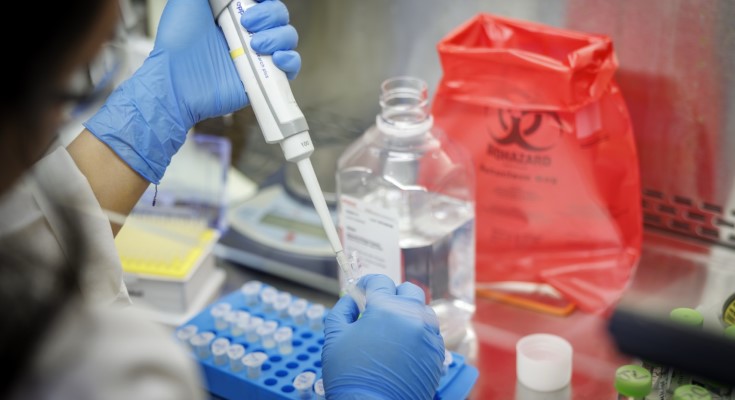World
Pennsylvania Bolsters Biosecurity as Avian Influenza Threatens Poultry

HARRISBURG, PA — Pennsylvania agriculture officials are intensifying efforts to combat the ongoing threat of avian influenza, crucial for safeguarding a poultry industry valued at $7.1 billion. During a recent tour of the Pennsylvania Veterinary Laboratory, Deputy Secretary for Animal Health and Food Safety Lisa Graybeal underscored the importance of early testing and stringent biosecurity measures in the fight against Highly Pathogenic Avian Influenza (HPAI). This initiative comes on the heels of new infections reported at six poultry farms in Lancaster County, affecting nearly 58,000 birds.
Since the onset of the latest HPAI outbreak in February 2022, Pennsylvania has faced significant losses, with over 7.1 million birds impacted across 100 flocks in 23 counties. This crisis marks one of the most severe animal health challenges in the state’s history. Graybeal credited the coordinated response and investment in laboratory testing for reducing losses and ensuring the safety of Pennsylvania’s poultry products.
“Our testing to monitor and detect avian influenza has been an indispensable tool to minimize damage during what has been the biggest animal health crisis in American history,” Graybeal stated. “Our veterinary teams, farmers, and state partners have shown unwavering commitment to recovery and prevention.”
Strengthening Laboratory Capabilities
The state operates three diagnostic facilities in Harrisburg, University Park, and Kennett Square, which processed over 672,000 animal health samples in the past year. A fourth laboratory is currently under renovation at Penn State’s Beaver Campus, aimed at enhancing testing capacity and response times, supported by a $6 million investment included in the 2024–25 budget, with an additional $2 million proposed for the following year.
State Veterinarian Dr. Alex Hamberg emphasized that effective biosecurity measures on farms are just as critical as laboratory testing. “When every farm has a biosecurity plan and everyone who enters follows it, disease risks are lower and recovery is quicker,” he explained.
To support producers affected by the outbreak, the Shapiro Administration has disbursed nearly $15.7 million in HPAI Recovery Grants to 292 applicants, with $59.6 million still available in reserve. The administration’s budget proposal for 2025–26 includes an additional $11 million to sustain funding for recovery and prevention initiatives.
Potential Economic Impact
Industry leaders have noted the importance of continued state support. “Pennsylvania has set a gold standard for animal disease response,” remarked Chris Herr, Executive Vice President of PennAg Industries. “Our labs, grants, and coordinated response ensure that poultry farmers can recover and stay in business.”
Experts caution that the forthcoming months will be critical as migratory birds, known to spread HPAI, migrate through the region. Renewed infections could adversely affect poultry exports, tighten egg supplies, and drive up food prices. Nevertheless, the state’s expanded testing network and recovery funding are anticipated to alleviate economic repercussions and maintain long-term stability within the industry.
With poultry being one of Pennsylvania’s leading agricultural sectors, preserving consumer confidence and farmer resilience remains a top priority. The state’s comprehensive surveillance and funding strategies may serve as a model for other agricultural regions facing similar biosecurity challenges.
-

 Business2 weeks ago
Business2 weeks agoIconic Sand Dollar Social Club Listed for $3 Million in Folly Beach
-

 Politics2 weeks ago
Politics2 weeks agoAfghan Refugee Detained by ICE After Asylum Hearing in New York
-

 Health2 weeks ago
Health2 weeks agoPeptilogics Secures $78 Million to Combat Prosthetic Joint Infections
-

 Science2 weeks ago
Science2 weeks agoResearchers Achieve Fastest Genome Sequencing in Under Four Hours
-

 Lifestyle2 weeks ago
Lifestyle2 weeks agoJump for Good: San Clemente Pier Fundraiser Allows Legal Leaps
-

 Health2 weeks ago
Health2 weeks agoResearcher Uncovers Zika Virus Pathway to Placenta Using Nanotubes
-

 World2 weeks ago
World2 weeks agoUS Passport Ranks Drop Out of Top 10 for First Time Ever
-

 Business2 weeks ago
Business2 weeks agoSan Jose High-Rise Faces Foreclosure Over $182.5 Million Loan
-

 World2 weeks ago
World2 weeks agoRegional Pilots’ Salaries Surge to Six Figures in 2025
-

 Science2 weeks ago
Science2 weeks agoMars Observed: Detailed Imaging Reveals Dust Avalanche Dynamics
-

 Entertainment2 weeks ago
Entertainment2 weeks agoJennifer Lopez Addresses A-Rod Split in Candid Interview
-

 Top Stories2 weeks ago
Top Stories2 weeks agoChicago Symphony Orchestra Dazzles with Berlioz Under Mäkelä









